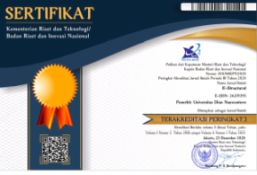The Relationship between Students’ Perceptions on Online Slack Application and Their Motivations in Writing Skill
Abstract
Abstract. This present study aims to investigate the correlation between students’ perceptions of Slack application and their motivations in writing skills. An analysis of the research literature in perception and motivation as Wei and Elias (2011) theory revealed that students’ perceptions of classroom environment play an essential role in promoting students’ motivation in learning a language. A quantitative correlation was used in this present study. Thus, the data were collected by employing close-ended questionnaires towards Likert Scale technique. However, this study was conducted at one university in Tasikmalaya. The findings show that the correlation coefficient of rxy is 0.77. According to the strength of the correlation table, the rxy= 0.77 lies between 0.75 and 0.99 which means there is a correlation between students’ perceptions of online Slack application and their motivations in writing. This study suggested that Slack Application can be used as an alternative to facilitate students’ engagement in classroom activities.
Keywords: ICT, Slack application, students’ motivation, writing skill
Abstrak. Tujuan dari penelitian ini adalah untuk menyelidiki hubungan yang ada antara persepsi siswa tentang aplikasi Slack dan motivasi mereka dalam keterampilan menulis. Analisis literatur penelitian dalam persepsi dan motivasi sebagai teori Wei dan Elias (2011) mengungkapkan bahwa persepsi siswa tentang lingkungan kelas memainkan peran penting dalam mempromosikan motivasi siswa dalam belajar bahasa. Korelasi kuantitatif digunakan dalam penelitian ini. Dengan demikian, pengumpulan data dilakukan dengan menggunakan kuesioner tertutup terhadap teknik Skala Likert. Namun penelitian ini dilakukan di salah satu Universitas di Tasikmalaya. Hasil penelitian menunjukkan bahwa rxy memiliki koefisien korelasi sebesar 0,77. Berdasarkan tabel kekuatan hubungan, rxy = 0.77 berada di antara 0.75 dan 0.99 yang berarti hubungan tersebut sangat kuat. Studi ini menyarankan bahwa Slack Application dapat menjadi cara lain untuk memfasilitasi keterlibatan siswa dalam kegiatan kelas.
Kata kunci: aplikasi Slack, ICT, keterampilan menulis, motivasi siswa
Full Text:
PDFReferences
Agca, R. K., & Ozdemir, S. (2013). Foreign language vocabulary learning with mobile technologies. ELSEVIER, 83, 781 – 785.
Aghaee, N., & Keller, C. (2016). ICT-supported peer interaction among learners in Bachelor’s and Master’s thesis courses. Computers & Education, 94, 276–297.
Ahmadi, et.al. (2011). The application of information and communication technologies (ICT) and its relationship with improvement in teaching and learning. ELSEVIER, 28, 475-480.
Alvarez, G., & Bassa, L. (2013). ICTs and collaborative learning: A case study of a class blog for improving the writing skills of pre-university students. Universities and Knowledge Society Journal (RUSC). 10(2), 254-268.
Amin, S. N. (2013). An effective use of ICT for education and learning by drawing on worldwide knowledge, research and experience: ICT as a change agent for education. Scholarly Journal of Education, 2(4), 38-45.
Anastasiades, P., & Zaranis, N. (2017). Research on e-learning and ICT in education: Technological, pedagogical and instructional perspectives. Switzerland: Springer.
Ardiansah, D. (2015). An analysis of modality in students’ hortatory exposition texts: Systemic functional grammar perspective. Bahasa & Sastra, 15(2), 136-149.
Atai, M. R., & Alipour, M. (2011). The effect of the combination of small group conferencing and portfolio procedure on EFL students' writing accuracy. Innovation in Language Learning and Teaching, 6(6), 97-112.
Azmi, N. (2017). The benefits of using ICT in the EFL classroom: From perceived utility to potential challenges. Journal of Educational and Social Research, 7(1), 111-118.
Cao, Y., Ajjan, H., & Hong, P. (2013). Using social media applications for educational outcomes in college teaching: A structural equation analysis. British Journal of Educational Technology, 44(4), 581-593.
Clark, R. C, & Mayer, R. E. (2011). E-learning and the science of instruction: Proven guidelines for consumers and designers of multimedia learning (4th Ed). New York: John Wiley & Sons.
Compton, L. K. L. (2009). Preparing language teachers to teach language online: A look at skills, roles, and responsibilities. Computer Assisted Language Learning, 22(1), 73-99.
Cowie, B. & Jones, A. (2009). Teaching and learning in the ICT environment. In L. J. Saha & A. G. Dworkin (Eds.) International Handbook of Research on Teachers and Teaching: Part One (pp. 791-801). New York: Springer.
Creswell, J. W. (2014). Research design: Qualitative, quantitative, and mixed methods approaches (4th ed.). London: SAGE publications.
Ghavifekr, S., & Rosdy, W. A. (2015). Teaching and learning with technology: Effectiveness of ICT integration in school. International Journal of Research in Education and Science (IJRES), 1(2), 175-191.
Gofine, M., & Clark, S. (2017). Integration of slack, a cloud-based team collaboration application, into research coordination. Journal of Innovation in Health Informatics, 24(2), 252–254.
Halki, P., & Politis, P. (2014). Teaching informatics in primary school with and without educational software support. In C. Karagiannidis et al. (Eds.). Research on e-Learning and ICT. New York: Springer Science & Business Media.
Heryandi, et.al. (2020). Online teaching in writing by using means of slack application. Journal of English Education and Teaching (JEET), 4(1), 49-68.
Hidayati, K.H. (2018). Teaching writing to EFL learners: An investigation of challenges confronted by Indonesian teachers. Journal of the Association for Arabic and English. 4(1), 21-31.
Hrastinski, S. (2008). Asynchronous and synchronous e-learning. Educause Quarterly, 31(4), 51–55.
Hsu, L., & Sheu, C. M. (2008). A study of low English proficiency students’ attitude toward online learning. Electronic Journal of Foreign Language Teaching 5(2), 240–264.
Hyland, K. (2003). Second language writing. New York: US: Cambridge University Press.
Ke, I. C., & Suzuki, T. (2011). Teaching global English with NNS-NNS online communication. The Journal of Asia TEFL, 8(2), 169-188.
Lomax, R. G., & Li, J. (2008). Correlational research. In E. M. Anderman (Ed.), Psychology of classroom learning: An encyclopedia (pp. 275-278). Detroit: Macmillan Reference.
Malik, R. S., & Hamied, F. A. (2016). Research methods: A guide for first time researchers (2nd ed). Bandung: UPI Press.
Mbangwana, M. A. (2008). Introduction of ICT in schools and classrooms in Cameroon. In K. Toure, T.M.S. Tchombe, & T. Karsenti (Eds.). ICT and Changing Mindsets in Education, Bamenda, Cameroon: Langaa; Bamako, Mali: ERNWACA / ROCARE
Meenakshi. (2013). Importance of ICT in education. IOSR Journal of Research & Method in Education, 1(4), 3-8.
Parveen, J. J., and Rajesh, V. (2011). Multimedia in English language teaching: An empirical analysis. Journal of Technology for ELT, 1(4).
Perkel, J.M. (2017). How scientists use slack. Nature, 541, 123–124.
Raja, P., & Nagasubramani, P. C. (2018). Impact of modern technology in education. Journal of Applied and Advanced Research, 3(1), 33-35. https://dx.doi.org/10.21839/jaar.2018.v3S1.165
Ramezani, M., Kaffash, H., Kargiban, Z., & Kargiba. (2010). A close look into role of ICT in education. International Journal of Instruction, 3(2), 63-82.
Rodríguez, P., Nussbaum, M., & Dombrovskaia, L. (2012). ICT for education: A conceptual framework for the sustainable adoption of technology-enhanced learning environments in schools. Technology, Pedagogy and Education, 21(3), 291-315.
Salehi, et.al. (2015). Using e-learning and ICT courses in educational environment: A review. English Language Teaching, 8(1), 63-70.
Shahsavar, Z., & Hoon, T. B. (2010). Using weblogs to promote critical thinking through asynchronous online discussion. The Journal of Asia TEFL, 7(1), 309-331.
Stake, R. E. (2010). Qualitative research: Studying how things work. New York: London: The Guilford Press.
Subana., Rahadi, M., Sudrajat. (2000). Statistik Pendidikan. Bandung: Pustaka Setia.
Taylor, R., King, F. & Nelson, G. (2012). Student learning through social media. Journal of Sociological Research, 3(2), 29-35.
Verma, A. (2011). Multimedia and ICT in English education. Journal of Technology for ELT. (7th ed.).
Wardono, et.al. (2018). Development of innovative problem based learning model with PMRI-scientific approach using ICT to increase mathematics literacy and independence-character of junior high school students. Journal of Physics: Conference Series, 983(1). https://doi:10.1088/1742-6596/983/1/012099
Wei, L. S., & Elias, H. (2011). Relationship between students’ perceptions of classroom environment and their motivation in learning English language. International Journal of Humanities and Social Science. 1(21), 240-250.
Williams, R.T., and Lutes, P. (2013). Using video in the ESL classroom. Cambridge Journal of Education 34(3), 331-351.
Yang, C., & Chang, Y. (2012). Assessing the effects of interactive blogging on student attitudes towards peer interaction, learning motivation, and academic achievements. Journal Of Computer Assisted Learning, 28(2), 126-135. https://doi:10.1111/j.1365-2729.2011.00423
Yastibas, A. E., & Yastibas, G. C. (2015). The use of e-portfolio-based assessment to develop students’ self-regulated learning in English language teaching. ELSEVIER: Social and Behavioral Sciences 176, 3-13.
DOI: https://doi.org/10.33633/es.v4i01.4431
Article Metrics
Abstract view : 423 timesPDF - 218 times
Refbacks
- There are currently no refbacks.
Accredited by:
Indexed by:
In Collaboration with:

This work is licensed under a Creative Commons Attribution 4.0 International License.

























